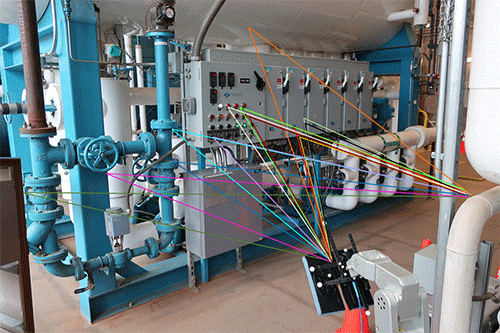NIST finds wireless performance consistent across 5G mmWave bands
June 2022
Industrial Wireless

Wireless transmissions can take many routes to the intended receiver. The coloured lines are reconstructions of measured paths of millimetre-wave signals between a transmitter (not visible) and receiver (lower middle) in an NIST industrial control room. Each path is precisely characterised in terms of length and angle to the receiver. These paths are all secondary, meaning reflected or diffracted signals.
Settling a key dispute in the wireless communications field, researchers at the US National Institute of Standards and Technology (NIST) found that transmission performance is consistent across different bands of the millimetre-wave (mmWave) spectrum targeted for high-speed, data-rich 5G systems.
Wireless systems are moving to the mmWave spectrum at 10-100 GHz, above crowded cellular frequencies as well as early 5G systems around 3 GHz. System operators tend to prefer lower bands of the new mmWave spectrum. One reason is that they are influenced by a formula that says more signals are lost at higher frequencies due to smaller wavelengths, resulting in a smaller useful antenna area. But until now, measurements of this effect by many organisations have disagreed over whether this is true.
NIST researchers developed a new method to measure frequency effects, using the 26,5-40 GHz band as a target example. After extensive study in the laboratory and two real-world environments, NIST results confirmed that the main signal path – over a clear “line of sight” between transmitter and receiver – does not vary by frequency, a generally accepted thesis for traditional wireless systems but until now not proven for the mmWave spectrum. The results are described in a new paper https://ieeexplore.ieee.org/document/9759479.
The team also found that signal losses in secondary paths – where transmissions are reflected, bent or diffused into clusters of reflections – can vary somewhat by frequency, depending on the type of path. Reflective paths, which are the second strongest, and critical for maintaining connectivity, lost only a little signal strength at higher frequencies. The weaker bent and diffuse paths lost a bit more. Until now, the effects of frequency on this so-called multipath were unknown.
“This work may serve to demystify many misconceptions about propagation around higher frequencies in 5G and 6G,” NIST electrical engineer Camillo Gentile said. “In short, while performance will be worse at higher frequencies, the drop in performance is incremental, so we do expect the deployment at 5G and eventually at 6G to be successful.”
The NIST method emphasises innovative measurement procedures and enhanced equipment calibration to make sure only the transmission channel is measured. The researchers used NIST’s SAMURAI (Synthetic Aperture Measurement UnceRtainty for Angle of Incidence) channel sounder, which supports design and repeatable testing of 5G mmWave devices with unprecedented accuracy across a wide range of signal frequencies and scenarios. The NIST system is unique in that antenna beams can be steered in any direction for precise angle-of-arrival estimates.
NIST’s main innovations in the new study, as discussed in the paper, were calibration procedures to remove the effects of channel sounder equipment from the measurements, extension of an existing algorithm to determine from a single measurement how individual paths vary by frequency, and studies in an industrial control centre and a conference room to classify the types of paths involved and determine any frequency effects.
Further reading:
Senseca introduces data loggers to meet long range transmission needs
Senseca
Industrial Wireless
Senseca has introduced the driven LR35 data logger series based on LoRaWAN technology. They are specifically designed for situations where long-range transmission is required.
Read more...
Omniflex upgrades alarms for Uganda hydro plants
Omniflex Remote Monitoring Specialists
Industrial Wireless
Omniflex has worked with Uganda Electricity Generation Company to provide an upgrade solution for the plant alarm equipment across the Nalubaale and Kiira hydroelectric power stations on Lake Victoria.
Read more...
New RFID communication module
Siemens South Africa
Industrial Wireless
The new Siemens RFID communication module, Simatic RF128C enhances efficiency and flexibility, making it ideal for applications in the battery, electronics and semiconductor industries.
Read more...
Advanced missing person locator system to boost mine safety
Industrial Wireless
Becker Mining South Africa has enhanced its state-of-the-art Missing Person Locator system, a powerful module integrated into the company’s comprehensive SmartFlow digital mine visualisation and management platform, designed to enhance emergency preparedness and personnel safety in mining operations worldwide.
Read more...
New RFID communication module
Siemens South Africa
Industrial Wireless
The new Siemens RFID communication module, Simatic RF128C enhances efficiency and flexibility, making it ideal for applications in the battery, electronics and semiconductor industries.
Read more...
A South African legacy in telemetry
Interlynx-SA
Editor's Choice Industrial Wireless
Telemetry is becoming a vital component of industrial strategy, allowing companies to harness real-time data to optimise processes and reduce waste. One company leading this technological shift is Interlynx.
Read more...
Remote monitoring in remote and harsh environments
Omniflex Remote Monitoring Specialists
Industrial Wireless
For power grids, water supply networks and many industrial facilities, managing infrastructure in remote locations is a significant challenge. Omniflex discusses the requirements for remote monitoring equipment deployed in remote and harsh environments, and shares an example from the company’s work with a South African electricity supply company.
Read more...
Plant to control room visibility
Omniflex Remote Monitoring Specialists
Industrial Wireless
When Sasol’s Secunda power plant in South Africa was looking for ways to improve productivity and maintenance responsiveness, it approached remote monitoring experts, Omniflex for real-time monitoring of its electrostatic precipitators across 17 substations.
Read more...
Steinmüller Africa’s drone technology
Industrial Wireless
Steinmüller Africa’s intelligent engineering services has expanded with the addition of the Elios 3 caged inspection drone to its fleet, enhancing inspection capabilities and reducing costs for power stations by reducing the need for human inspection services.
Read more...
Upgrading Australia’s first switch-mode CP installation
Omniflex Remote Monitoring Specialists
Industrial Wireless
Omniflex has completed a system upgrade for the switch-mode cathodic protection system installation protecting a premium residential precinct in Melbourne, upgrading its remote monitoring with 4G connectivity
Read more...


